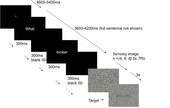Highlight
Multi-Voxel Pattern Analysis of Noun and Verb Differences in Ventral Temporal Cortex
Achievement/Results
Christine Boylan, IGERT trainee and psychology graduate student at the University of Pennsylvania, has recently developed a novel functional Magnetic Resonance Imaging (fMRI) experimental paradigm to study the neural correlates to on-line sentence processing, focusing especially on how the brain makes predictions about upcoming words in a sentence.
Past psycholinguistic research [1,2] has shown that there exists a probabilistic relationship between the syntactic category of a word (i.e., whether it is a Noun or a Verb) and how that word is spelled and pronounced in English (i.e., its orthographical and phonological properties). Boylan set out to determine if the brain predicts such orthographical /phonological properties of upcoming words during reading. In Boylan’s fMRI study, participants read sentence fragments that could continue using a range of possible words, but generated a high expectation that the word in question would be a Noun (as in Example 1) or a Verb (as in 2).
1. When did the janitor mention the ____ ? [Noun likely to be next.]
2. Which budget was the mechanic permitted to ___ ? [Verb likely to be next.]
Participants viewed the sentences in the fMRI scanner, one word at a time, ending with a random-dot pattern on the screen, as illustrated in Figure 1.
Participants were to hit a button when they saw a word emerge slowly from the random dots and then judge whether that word fit into the sentence. Unbeknownst to the participants, the first 4, 6 or 8 seconds of the random dots contained no visual information about the word and were truly just random dot patterns. By examining at the fMRI brain signal during this period of time, especially late in this period, Boylan can be certain that the brain activity was not being driven by any (useful) visual information that the participant was currently perceiving from the screen. Rather, the brain activity during this time period had to be driven by the participant’s predictions about what kind of word was about to emerge from the random dots.
Boylan then examined the pattern of brain activity during this time period using a technique known as multi-voxel pattern analysis. Specifically, she attempted to use the brain voxel patterns to classify trials into those that were Noun-predicting contexts vs. those that were Verb-predicting contexts. If one can successfully do such a classification, it means that the area in question encodes something related to this syntactic prediction.
Boylan found that activity in the Visual Word Form Area (VWFA) could reliably classify Noun-predicting contexts from Verb-predicting contexts, even when the participant was not viewing any linguistic material on the screen, as illustrated in Figure 2.
Because the Visual Word Form Area is believed to encode information about a word’s orthographic properties, but not its syntactic class, Boylan has hypothesized that the brain is using syntactic cues to predict the orthographic and phonological properties of upcoming words, using information about how Nouns and Verbs differ in orthographic properties [1, 2]. Interestingly, she did not find similar classification abilities in Primary Visual Cortex, suggesting that the prediction is linguistic rather than visual in nature.
Such findings are important to our understanding of how the brain processes visual information during reading. By understanding the neural-computational system that is normally deployed during reading, we may be able to build better computational systems of language processing and improve our understanding of brain dysfunctions related to reading.
References:
1. Kelly, M.H. (1992). Using sound to solve syntactic problems: The role of phonology in grammatical category assignments. Psychological Review, 99, 349-364.
2. Farmer, T. A., Christiansen, M. H., and Monaghan, P. (2006). Phonological typicality influences on-line sentence comprehension. Proceedings of the National Academy of Sciences USA 10332, 12203-12208.
Biography: Christine Boylan is a graduate student in Psychology at the University of Pennsylvania, where she is advised by Professors Sharon-Thompson-Schill and John Trueswell. She graduated from the University of Chicago in 2008 with BA degrees in linguistics and biology (specializing in neuroscience). From 2008 to 2010 she worked at NYU’s Neurolinguistics Laboratory, where she conducted simultaneous MEG+EEG studies on syntactic/semantic processing. Her current research aim is to use fMRI pattern analysis techniques to study syntactic and semantic categorization and prediction effects. Her general interests include the neural bases of language comprehension, the syntax/semantics interface, and lexical access vs. composition mechanisms.
Address Goals
Boylan’s findings are important to our understanding of how the brain processes visual information during reading. By understanding the neural-computational system that is normally deployed during reading, we may be able to build better computational systems of language processing and improve our understanding of brain dysfunctions related to reading.
In addition, the work allowed Boylan to become an expert in cutting-edge multi-voxel fMRI classification methods.








